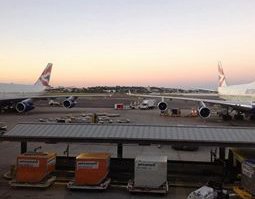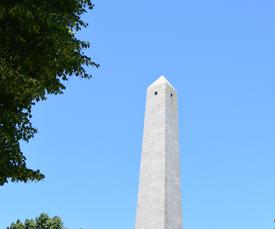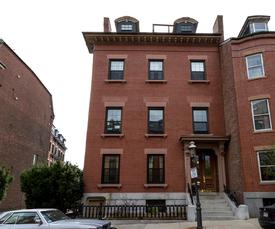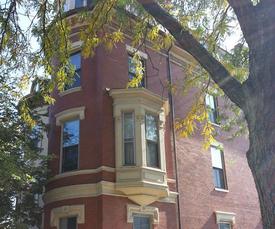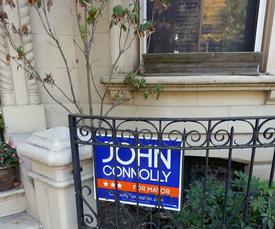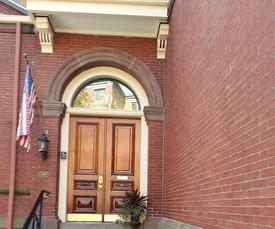
The
Adventurous
Danes
FOLLOW US ON FACEBOOK
Today's Golden Words |
1. Shutdown can't stop us |
2. Johannes V. Langkilde is awesome! |
3. Mahatma gave us an interesting lesson on racism in America today |
4. Can't find no ***damn Chipotle :( |
5. Now: The Bowling Danes |
6. We would pay one hundred dollar for a single beer right now... |
Boston City
One man down, or?
You may already have heard, but before 3.C left Denmark, Nanna had her passport stolen. Nanna did what anyone would've done if you get your passport stolen; she reported it stolen to the police. Luckily she found it in one of the dumpsters a long side the road from where it was stolen. Can you believe it? Three days before take-off, Nanna had her passport stolen and afterwards managed to find it, in one single day. The spirit was therefore kept high among our classmates, when we at 11:30 checked in, in Copenhagen airport. The troubles were yet to come.Fact is, that we are now sitting on the plain heading towards Boston, without Nanna! By the time we arrived at the airport in Keflavik, prepared to take our final flight towards Boston City, Nanna was called over the speakers. None of us had expected the shocking news Nanna was about to receive. The americans wouldn't let her take the flight due to the reason that her passport was accounted as missing according to their system. So here we are in a plain, one man less than when we took off from CPH. Nanna was forced to stay in Keflavik for the night, just to take a plain back to CPH tomorrow morning. We don't know what to expect and all we wish for, is for Nanna to be able to head towards the States untroubled by the faults of the danish and american police. We hope of nothing else.
The day after. Wow, we've had our ups and downs when it comes to missing passports, random security checks etc. We can now tell you that things are turning in a good direction. An employee at Keflavik Airport has made it possible for Nanna to enter the United States and she will arrive today!
Neighborhood Analysis and the Freedom Trail
02/10 2013
Today we started off by running 6 miles. Yes, 6 miles seems manageable to young people like us, but we do not believe that 8 am is the best time to run 6 miles. Despite the fact that we had a hard time getting out of bed, the conditions during the run were absolutely amazing. The clear blue sky, the rising sun and the enormous city of Boston in our sight made the run a great experience. It was a different way to experience Boston city.
Afterwards we spend rest of the day on the Freedom Trail. Some of the pictures we took on the trip are uploaded in the gallery down below. The Freedom Trail starts off close to our hostel and ends on the opposite side of Charles River in Charlestown. We chose to make our quarter analysis in Charlestown. The Freedom Trail is basically a 2.5 mile walk which will take you past 16 of Boston's most important historical landmarks. We went to see all of them. Nothing could stop The Adventurous Danes on this glorious day!
Charlestown is the oldest neighborhood in Boston formed by english immigrants back in the 18th century. It is a very authentic neighborhood compared to the buildings located in the center of Boston, which mainly consists of modern constructions. Charlestown is residential district with lots of small parks, and sculptures. There are many trees on the streets and the environment is very quiet. The streets are cleaned every day and not the traffic is calm. Charlestown is located on the northern side of Charles River. Charlestown is known for its large population of Irish-americans. Charlestown has a population of 16.500 people. Compared to the rest of the country, Charlestown's cost of living cost of living is 69.10 % higher than the U.S average. The unemployment rate is 6.00 % which is
2 % lower than the average unemployment rate in the US.
We were surprised how familiar the placed seemed to us when we walked down Chestnut St. Its colonial, red-brick, row-house housing stock, was similar to that of the wealthy area of Beacon Hill. There is no doubt that this is a place where many people from the upper-middle class lives. All the doors to the entries were made of fine solid varnished oak, but the reb-bricks was the element that made it clear to us, that this town was different from most of Boston. Charlestown is the home of significant landmarks such as the U.S.S. Constitution, the Bunker Hill Monument and the Navy Yard. Charlestown even has it's own authentic red-brick firestation (seen on the pictre below). By comparing our observations of the town and the statistics brought in from the web, it is pretty clear to us that Charlestown is an upper-middle class neighborhood.
Quarter Analysis Gallery
Freedom Trail Gallery
Our Journey To Harvard University
1/10 2013
There are not many who haven't heard of the famous university and college Harvard. Harvard University has through many generations been known as one of the most prestigious universitites in the western world, if not the entire world. The university is situated in northwestern part of the MIT (Massachusetts Institute of Technology). Due to its popularity and prestige, Harvard only has an acceptance rate of 5 %. There are 10,000 students studying at Harvard.
We were introduced to the university by the college student Molly (19 years old). She was a second year student who could tell us everything we wanted to know. Everything from parties (even though you are not 21), sports, classes, relationships between freshmen and seniors, the history of Harvard, to Final Clubs and the rivalry between Yale and Harvard.
Did our Harvard experience match the expectation we had of the harvard "spirit" before we entered of the campus? Definately not. This "spirit" was way more relaxed and calm than we thought it would've been. The people wore casual clothes, not suits or school uniforms. Even though the fee per semester is 40,000 dollars, Harvard still acccepts people who cannot afford this, if they have the required qualificattions. in the end everyone can enter Harvard, poor or rich, you just need to have the required qualifications (academicly or athletic).
Interviews
Interview: Raga, Mary and Rachel
We met an Indian student named Raga, age 25. Raga has experienced racism in America and still believes that racism is present. It shows in a "little form" (qt. Raga) where the black and white are segregated. You would think that the segregation would therefore be between Indians, Asians etc. yet Raga points out that he had never experienced a racist assault on him, "I have never faced any sort of racist attack on me, but I do feel that there is still not an open acceptance for people from all colors" (qt. Raga). Regarding racism on Harvard Campus, it is non-existing. We believe there is a connection between one's educational level and one's tolerance towards other ethnicities. The more you know about the ethnicities' culture, the higher level of tolerance you have. Your knowledge erases all the stereotypical and generalising prejudices. Furthermore, Harvard is a very international university with a great ethnic diversity. This weakeness the chance of any segregation between different ethnicities.
Raga does believe that the segregation between the black and white will shrink in the future. Fingers crossed.
Afterwards we met a girl from Connecticut named Mary, age 18. Surprisingly eloquent. Just like Raga mentioned in his interview, Mary has never experienced racism in the Harvard community. When you talk about other areas, like for example California or further south, Mary says that racism is present, " (...) talking to some people from California and further south and they definately have more problems with it than I have ever encountered being from the north east." (qt. Mary). According to Mary their is a clear difference between the North and the South when it comes to racism. It kind of takes us back to the civil war and the Confederacy vs. the Union. Definately a coherens. Furthermore, Mary doesn't believe that the globalism in our world has led to a post-racial society where racism doesn't exist. Instead the solution would be to create dialogue and debate, so that people realise that the prejudices they have aren't true.
The last interview we wish to include from our excursion to Harvard is an interview of the 25 years old lady Rachel. Rachel grew up in Peoria, Illinois. We were lucky to meet Rachel because she had made a project on the civil rights movement. It occured to us, that the the opinions stated by the three students we had interviewed seemed extremely similar to each other. Most likely due to their similar educational level. Rachel says:"I wouldn't say that their is less racism, it is just not as prominent (...) I'm not getting called the N-Word to my face every other day, but people definately still have prejudices". A few weeks before we traveled to the States, 3.C wrote an assignment on the article The Good, Racist People, by Ta-Nehisi Coates.(http://www.nytimes.com/2013/03/07/opinion/coates-the-good-racist-people.html?_r=0). The core issue which Coates strives to disseminate and highlight to the general population, is the same issue mentioned by Rachel. Racism is still going strong in the USA, yet the direct and more evident form of racism has transformed into an invisible racism. The prejudices is the core of the issue. We did agree with the three Harvard students, that a solution to this issue would be to "create a dialogue and just make people realise that some assumptions they may or may not have aren't necessarily true." (qt. Mary). Furthermore, we can all agree on the fact that media has a huge influence on people's prejudices against other races, yet it can also be a, "powerful tool" (qt. Rachel) to encourage debate about the "violent" issues rarely debated by the general public.
Copyright © All Rights Reserved
